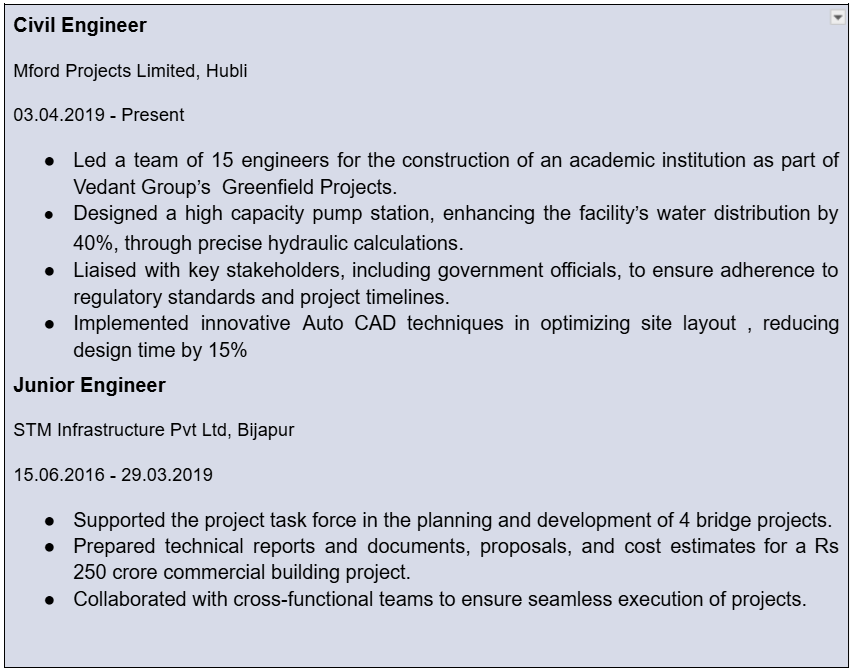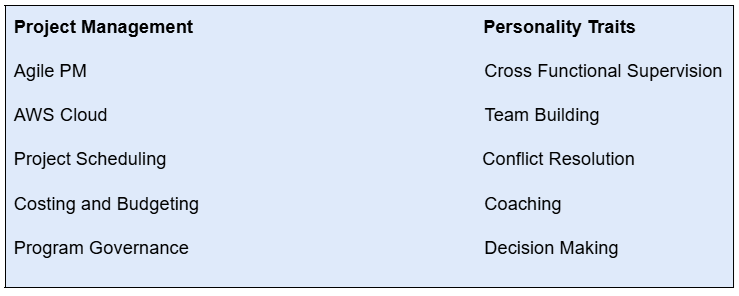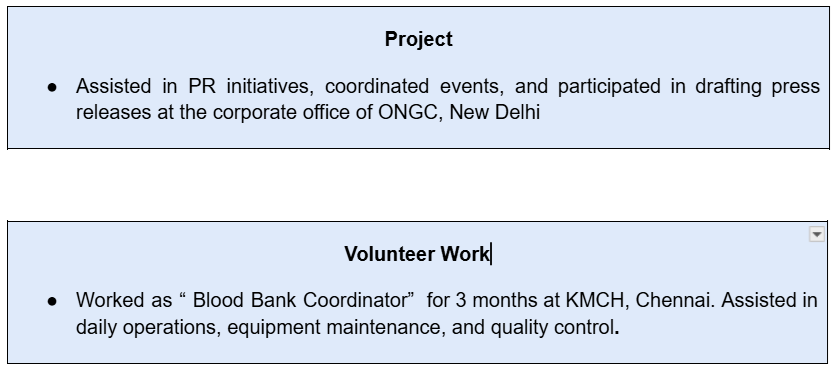Wondering how to create a resume that grabs attention and helps you land your dream job? Here’s a step-by-step guide to help you craft a professional and impressive resume.
Seeking a job in an ever-evolving job market has become an arduous project that needs diligent management. Rapid technological advancements, changing landscape of skills and nature of work, global events, etc. are some pressing issues that have contributed to the rise in the applicant-to-hire ratio.
Why Do You Need A Compelling Resume ?
Based on a study conducted by Glassdoor, each of their job postings typically receives 250 resumes on an average among which 4-6 convert in an interview, and eventually one gets hired at the end of the hiring process. In this scenario, job seekers must steer through a swarm of applications to garner the attention of recruiters. This highlights the significance of building a resume that stands out, leaving a lasting impression.
A professionally crafted resume is a potential marketing tool that persuades recruiters to move forward with your application. It intends to showcase your qualifications, skills, and achievements and convey your suitability for the desired role. This blog will guide you through key components of a successful resume using examples from various industries for practical insights.
How Do I Create A Resume – Step by Step Guide?
Struggling to create a perfect resume? Trying to find the answer of “What should I include in my resume in 2025?”
The best resume format for 2025 is a hybrid format that combines chronological and functional styles. Follow these 9 ATS friendly expert tips to craft a compelling resume that captures recruiters’ attention and boosts your chances of getting hired.
1. Select the most fitting template
Presentation matters. As much as it matters what you want to say, how you want to say, matters even more.
Before you start working on your resume, consider choosing a format that best aligns with your professional experience.
Among the many traditional and contemporary resume formats, the reverse chronological resume is widely acknowledged and accepted, for it facilitates the recruiters to swiftly scan and spot relevant details about the candidate. This resume format lists your employment history in reverse chronology from the most recent to the oldest position held and includes the subsequent sections.
- Contact Information
- Resume Profile
- Work Experience
- Skill Sets
- Education
- Additional Sections
2. Work on layout and design
The best resumes are those that are immaculately formatted. A well-structured resume elevates visual representation and demonstrates professionalism. Here are a few steps to format your resume.
Resume Length
How many pages should you write depends on your experience level and the industry to which you belong. You can keep your content to one page if you have less than 10 years of experience. In case you have extensive experience of more than a decade with notable achievements, you can consider extending it to two pages.
Font and Size
Prioritize clean and classic fonts like Arial, Calibri, Helvetica, as they enhance readability.
For headers, you can set font points to 14-16, for section titles, 12-14 points, and for body text, 10-12 points.
Layout and Spacing
For lucid presentation, set margins to 0.5-1 inch on all sides, and for body text, set line spacing at 1-1.15. Deploy spacing between sections and use justify alignment for body text.
Bullet Points
Highlight different sections with bullet points. On an average 4-5 bullet points is an ideal range for effective visual organization.
For optimal formatting, we suggest you prepare the document from scratch. Using a customized template is also a viable option if you can easily adjust the layout and design.
Save File in PDF
Always save your document in standard PDF format, as it is easier to share, preserves original formatting, and enhances readability.
Now that you are acquainted with the formatting guidelines, its time to add subsequent sections and assess each of them individually
3. Add your personal details
Carefully incorporate your contact details, as it is one vital piece of data on your resume. Inaccurate information can discourage recruiters from reaching out to you, and you can end up waiting for that interview call you badly wanted.
- You can choose to use the header for this section and fill with
- Your full name, preferably in large bold fonts
- A working phone number
- A professional email address
- Your present location
- Link to your digital profile ( LinkedIn, Portfolio, Website)
Check out a sample of how to write your communication details

4. Write an impressive Resume Profile
A resume profile is a brief summary about who you are , what have you done, and what can you do in not more than 4 lines. It is a succinct description of your skills, experience, passion about your profession, and career aspirations.
Recruiters skim resumes quickly, looking for key information about the applicants suitability for the job role. So, you need to do your best to make your introduction pitch impactful and enticing.
Also Read: Resume Trends in 2025 : Everything you need to know about modern resume writing
Here are a few examples of how to make your profile section engaging.

5. Write about your work experience and achievements
Your employment history is the heart of your resume. Research indicates that more than 65% of recruiters prioritize work experience above all else. They review your work history to get an idea of your past experience, relevant accomplishments, and how well your profile matches their candidate expectation.
Lets explore how to make this section effective
- First things first, list your job roles in reverse chronological order by including your job title, company name, location, and dates of employment.
- Communicate in active voice E.g., conducted campaigns, implemented SOP’s, boosted sales, etc. by using strong action verbs to link your contribution with the overall success of the organization.
- Quantify your accomplishments in numbers wherever possible. E.g, Improved lead generation by 25%. It gives a realistic overview of the achievements in your previous positions.
- While you continue to document, remember to
- Tailor your resume for each job application by using keywords from the job posting and carefully align your skills and experience with the job description.
- Abstain from exaggerating your accomplishments to sound practical and not boastful.
- Avoid using too much jargon and generic phrases.
Check out a sample of experience section

6. Display your top skills in a designated section
Recruiters look for specific skill sets on your resume that strongly match the job specification. This is where your skills section can come in handy.
Skills vary with the job role, industry, and experience level. Ideally, skills are classified into hard skills and soft skills. What skills should you include depends on the value they add to your profile.
Lets take an example to put skills in a designated section
A Front End Developer is expected to be proficient in a bunch of technical skills, namely HTML, CSS, Javascript, Frameworks (Angular, React, Vue), Responsive Design, Testing, and Debugging, along with a couple of soft skills like creativity, problem solving, and teamwork.
On the contrary, for a Customer Care Executive knowledge of products and their uses, their specifications, product tariffs, product-specific policies, etc. are core hard skills, while, communication, active listening, emotional intelligence, problem solving, patience, and adaptability form the part of soft skills.
Now, before you jot down your skills on paper,
- Prepare a matrix of skills you wish to add, such as sections or subsections for different categories.
- Thoughtfully list skills that you have mastered.
- Evaluate the proficiency level of each skill.
- You can use a diverse combination of industry-specific skills, transferable skills, and language skills related to your profession.
- Make sure to mention relevant skills only.
Lets take a look at the skills section of a middle level tech project manager

7. Add your educational credentials
Be specific with the qualifications you want to portray. You may hold numerous degrees and certifications to your credit, but not all of them need to go on your resume, particularly when you are a mid-level or senior-level professional. Relevant academic coursework and specialized training that complements your professional role should suffice.
Follow the format if you are an experienced professional

If you are a fresher or an earlier entrant, you may expand on the details to include
Highest level of education, at the start followed with specialization
- University Name
- Graduation date or expected date of course completion
- Additional Certifications or Licenses
- Academic achievements such as A+ grades, awards, scholarships, etc.
Example of education section of a fresher

8. Make your additional section count
You may dedicate a little more space to cover miscellaneous sections on your resume. This segment can be optimally utilized by all professionals to pitch their caliber as a multifaceted professional. Depending on your experience level and individual achievements, you can customize these sections to add
Certification : If you have up-skilled yourself with more than a couple of relevant coursework , it is recommended to add a subsection under your basic educational information to strongly highlight your academic achievements.
Example :

Training : Including your participation in training programs from your profession can give a positive impression about your willingness to grow professionally.
Example:

Projects/ Volunteer Work: Some academic programs require you to engage in internships with companies to acquire practical knowledge of industrial practices. Conversely, you can also offer your services as a volunteer to get industrial exposure. Adding this section will greatly benefit if you have little or no experience to show.
Examples :

Awards & Honors : Listing your rewards and recognition can go a long way in validating your strong candidature. Recruiters mostly favor high achievers with a past record of exemplary performance.

Publications : In many academic, scientific, or writing professions, publications are an integral part of their field. You can create a dedicated section and add references to your published works in journals, websites, or magazines.
Example :

The additional sections on your resume need not be overwhelming, as it can take more space than needed. Mention only those that make you stand out.
9. Always Proofread
You are convinced that you have crafted a compelling resume that effectively showcases your experience, skills, and achievements, but still, it did not elicit as much response as you expected.
What went wrong was an inadvertent typo error you overlooked while applying for a job.
To avoid such a situation, double check your resume for possible spelling, grammar, and formatting errors, and you are good to go.
A video created by Ashish Pratap Singh on Youtube explaining ‘how to write a resume with examples’
Bottom Line
Writing a resume is a critical step towards job search. It is a living document that evolves with your career, so continue to refine it as you gain new experience. With the right approach, you can create an impressive resume that opens doors to new opportunities and helps you to stay ahead in the competition.
Also Read: HRIS vs HRMS vs HCM: Which Is Right HR Software for Your Business

[…] Also Read: https://stacksynk.com/blog/how-to-create-a-resume-step-by-step-guide/ […]